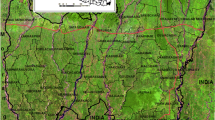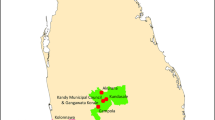Abstract
Examining the effect of environmental and social factors on populations exposed to vector-borne diseases is critical to prepare for future outbreaks. While extensive studies have been conducted on the epidemiology of the dengue virus, research on the human-environmental aspects of the disease is sparse. A multivariate analysis using constrained ordination is carried out to evaluate the spatial and temporal variations of the dengue virus in Sri Lanka. The constrained factor scores are mapped using geographic information systems software to identify clusters of high and low incidences of dengue. The results reveal distinct patterns of the virus in urban, peri-urban and rural districts. Mobility had a significant effect on populations exposed to the virus in both urban and peri-urban areas. The age cohort variables of percent population under the age of 5 and aged 5 to 19 had a negative impact on dengue rates in urban areas and a marginal impact in rural precincts. Precipitation, poverty, and literacy had a marginal to moderate impact on the prevalence of dengue at the district level. Three distinct clusters emerged from the resulting factor scores: an urban high cluster concentrated in the western region, a peri-urban/rural high cluster in the interior and northeastern region, and a rural low cluster in the dry zone. The size of the clusters varied during epidemic and non-epidemic years, but remained fairly consistent when the western districts were omitted. The district level assessment forms the basis for future evaluation of social-environmental factors related to dengue at the local level.










Similar content being viewed by others
References
Adger, W. N. (2006). Vulnerability. Global Environmental Change, 16(3), 268–281.
Anselin, L. (2003). Spatial econometrics. In B. H. Baltagi (Ed.), A companion to theoretical econometrics (pp. 310–330). Malden: Blackwell Publishing Ltd.
Bardosh, K. L., Ryan, S. J., Ebi, K., Welburn, S., & Singer, B. (2017). Addressing vulnerability, building resilience: community-based adaptation to vector-borne diseases in the context of global change. Infectious Diseases of Poverty. https://doi.org/10.1186/s40249-017-0375-2.
Bentham, G. (1992). Global climate change and human health. GeoJournal, 26(3), 7–12.
Bisanzio, D., Giacobini, M., Bertolotti, L., Mosca, A., Balbo, L., Kitron, U., et al. (2011). Spatio-temporal patterns of distribution of West Nile virus vectors in eastern Piedmont Region, Italy. Parasites & Vectors, 4, 230. https://doi.org/10.1186/1756-3305-4-230.
Bodinayake, C. K., Tillekeratne, L. G., Nagahawatte, A., Devasiri, V., Arachchi, W. K., Strouse, J. J., et al. (2018). Evaluation of the WHO 2009 classification for diagnosis of acute dengue in a large cohort of adults and children in Sri Lanka during a dengue-1 epidemic. PLOS Neglected Tropical Diseases, 12(2), e006258. https://doi.org/10.1371/journal.pntd.0006258.
Brightmer, M. I., & Fantato, M. G. (1998). Human and environmental factors in the increasing incidence of dengue fever: a case study from Venezuela. GeoJournal, 44(2), 103–109.
Centers for Disease Control and Prevention (CDC). (2012). Principles of epidemiology in public health practice, third edition: An introduction to applied epidemiology and biostatistics. https://www.cdc.gov/csels/dsepd/ss1978/lesson3/section2.html. Accessed 15 August 2019.
Centers for Disease Control and Prevention (CDC). (2018). Chikungunya virus. https://www.cdc.gov/chikungunya/index.html. Accessed 14 August 2019.
Connor, S. J., Da Silva, J., & Katikiti, S. (2007). Malaria control in southern Africa. In Climate risk management in Africa: Learning from practice. International Research Institute for Climate and Society (IRI). https://iri.columbia.edu/wp-content/uploads/2013/07/Climate-and-Society-No1_en.pdf. Accessed 2 July 2019.
Cutter, S. L., Barnes, L., Berry, M., Burton, C., Evans, E., Tate, E., et al. (2008). A place-based model for understanding community resilience to natural disasters. Global Environmental Change, 18, 598–606.
Cutter, S. L., Mitchell, J. T., & Scott, M. S. (2000). Revealing the vulnerability of people and places: A case study of Georgetown County, South Carolina. Annals of the Association of American Geographers, 90(4), 713–737.
Department of Census and Statistics—Sri Lanka. (2012). Census of population and housing 2012. http://www.statistics.gov.lk/PopHouSat/CPH2011/index.php?fileName=Activities/TentativelistofPublications. Accessed 2 July 2019.
Department of Census and Statistics–Sri Lanka. (2016). Household income and expenditure survey 2016. http://www.statistics.gov.lk/HIES/HIES2016/HIES2016_FinalReport.pdf. Accessed 2 July 2019.
Department of Census and Statistics—Sri Lanka. (2017). Sri Lanka labor force survey. http://www.statistics.gov.lk/samplesurvey/LFS_Annual%20Report_2017_version2.pdf. Accessed 2 July 2019.
Department of Census and Statistics—Sri Lanka. (2018). District Statistical Handbook. http://www.statistics.gov.lk/DistrictStatHBook.asp. Accessed 14 August 2019.
Department of Meteorology, Sri Lanka. (2014). Table 1.6: Annual and monthly rainfall at observation stations, 2008–2013. http://www.statistics.gov.lk/Abstract2014/CHAP1/1.6.pdf. Accessed 14 August 2019.
Department of Meteorology, Sri Lanka. (2018). Table 1.6: Annual and monthly rainfall at observation stations, 2012–2017. http://www.statistics.gov.lk/Abstract2018/CHAP1/1.6.pdf. Accessed 14 August 2019.
Department of Meteorology, Sri Lanka. (2019). Climate of Sri Lanka. http://www.meteo.gov.lk/index.php?option=com_content&view=article&id=94&Itemid=310&lang=en#2-southwest-monsoon-season-may-september. Accessed 2 July 2019.
Desjardins, M. R., Whiteman, A., Casas, I., & Delmelle, E. (2018). Space-time clusters and co- occurrence of chikungunya and dengue fever in Colombia from 2015 to 2016. Acta Tropica, 185, 77–85.
Eakin, H. (2005). Institutional change, climate risk, and rural vulnerability: cases from Central Mexico. World Development, 33(11), 1923–1938.
Epidemiology Unit, Ministry of Health. (2017). Disease surveillance—trends. http://www.epid.gov.lk/web/index.php?option=com_casesanddeaths&Itemid=448&lang=en#. Accessed 1 July 2019.
Goto, K., Kumarendran, B., Mettananda, S., Gunasekara, D., Fujii, Y., & Kaneko, S. (2013). Analysis of effects of meteorological factors on dengue incidence in Sri Lanka using time series data. PLoS ONE, 8(5), e63717. https://doi.org/10.1371/journal.pone.0063717.
Hagenlocher, M., Delmelle, E., Casas, I., & Kienberger, S. (2013). Assessing socioeconomic vulnerability to dengue fever in Cali, Colombia: Statistical vs expert-based modeling. International Journal of Health Geographics, 12(1), 36.
Hewitt, K., & Burton, I. (1971). The hazardousness of a place: a regional ecology of damaging events. Toronto: University of Toronto Press.
Hsueh, Y.-H., Lee, J., & Beltz, L. (2012). Spatio-temporal patterns of dengue fever cases in Kaoshiung City, Taiwan, 2003–2008. Applied Geography, 34, 587–594.
Kanakaratne, N., Wahala, W. M. P. B., Messer, W. B., Tissera, H. A., Shahani, A., Abeysinghe, N., et al. (2009). Severe dengue epidemics in Sri Lanka, 2003–2006. Emerging Infectious Diseases, 15(2), 192–199. https://doi.org/10.3201/eid1502.080926.
Kikuti, M., Cunha, G. M., Paploski, I. A. D., Kasper, A. M., Silva, M. M. O., Tavares, A. S., et al. (2015). Spatial distribution of dengue in a Brazilian urban slum setting: Role of socioeconomic gradient in disease risk. PLOS Neglected Tropical Diseases, 9(7), e0003937. https://doi.org/10.1371/journal.pntd.0003937.
Lepš, J., & Šmilauer, P. (2003). Multivariate analysis of ecological data using CANOCO. Cambridge: Cambridge University Press.
Machado-Machado, E. A. (2012). Empirical mapping of suitability to dengue fever in Mexico using species distribution modeling. Applied Geography, 33, 82–93.
Manyena, S. B. (2006). The concept of resilience revisited. Disasters, 30(4), 433–450.
Ng, K.-C., Chaves, L. F., Tsai, K.-H., & Chuang, T.-W. (2018). Increased adult aedes aegypti and culex quinquefasciatus (diptera: culicidae) abundance in a dengue transmission hotspot, compared to a coldspot, within Kaohsiung City, Taiwan. Insects, 9(3), 98. https://doi.org/10.3390/insects9030098.
Oliver-Smith, A. (2004). Theorizing vulnerability in a globalized world: A political ecological perspective. In G. Bankoff, G. Frerks, & D. Hilhorst (Eds.), Mapping vulnerability: Disasters, development, & people (pp. 1–9). London: Earthscan.
Oxford English Dictionary. (2019). https://www.oed.com/view/Entry/141110?redirectedFrom=peri+urban#eid. Accessed 2 July 2019.
PoundSterling Live. (2016). Historical rates for the USD/LKR currency conversion on 31 July 2016 (31/07/2016). https://www.poundsterlinglive.com/best-exchange-rates/us-dollar-to-sri-lankan-rupee-exchange-rate-on-2016-07-31. Accessed 14 August 2019.
Salje, H., Lessler, J., Berry, I. M., Melendrez, M. C., Endy, T., Kalayanarooj, S., et al. (2017). Dengue diversity across spatial and temporal scales: Local structure and the effect of host population size. Science, 355(6331), 1302–1306.
Singh, A. L., & Rahman, A. (2001). Malaria and related environmental issues in India: A case study of Aligarh city. GeoJournal, 53(1), 89–99.
Sirisena, P. D. N. N., & Noordeen, F. (2014). Evolution of dengue in Sri Lanka—changes in the virus, vector, and climate. International Journal of Infectious Diseases, 19, 6–12.
Šmilauer, P., & Lepš, J. (2014). Multivariate analysis of ecological data using CANOCO 5. Cambridge: Cambridge University Press.
Sun, W., Xue, L., & Xie, X. (2017). Spatial-temporal distribution of dengue and climate characteristics for two clusters in Sri Lanka from 2012 to 2016. Scientific Reports, 7, 12884. https://doi.org/10.1038/s41598-017-13163-z.
Sutherst, R. W. (2004). Global change and human vulnerability to vector-borne diseases. Clinical Microbiology Reviews, 17(1), 136–173.
Tam, C. C., Tissera, H., de Silva, A. M., De Silva, A. D., Margolis, H. S., & Amarasinge, A. (2013). Estimates of dengue force of infection in children in Colombo, Sri Lanka. PLOS Neglected Tropical Diseases, 7(6), e2259. https://doi.org/10.1371/journal.pntd.0002259.
ter Braak, C. J. F. (1996). Unimodal models to relate species to environment. Wageningen: DLO-Agricultural Mathematics Group.
ter Braak, C. J. F., & Šmilauer, P. (2012). Canoco reference manual and user’s guide: Software for ordination (version 5.0). Wageningen: Biometris, Wageningen University and Research Centre.
Thomson, M. C., Mason, S. J., Phindela, T., & Connor, S. J. (2005). Use of rainfall and sea surface temperature monitoring for malaria early warning in Botswana. The American Journal of Tropical Medicine and Hygiene, 73(1), 214–221.
Tutiempo Network, S. L. (2019). Climate data: Sri Lanka. https://en.tutiempo.net/climate/sri-lanka.html. Accessed 14 August 2019.
Weeraratne, T. C., Perera, M. D. B., Mansoor, M. A. C. M., & Karunaratne, S. H. P. P. (2013). Prevalence and breeding habitats of the dengue vectors aedes aegypti and aedes albopictus (diptera: culicidae) in the semi-urban areas of two different climatic zones in Sri Lanka. International Journal of Tropical Insect Science, 33(4), 216–226.
Wen, T.-H., Lin, N. H., Chao, D.-Y., Hwang, K.-P., Kan, C.-C., Lin, K. C.-M., et al. (2010). Spatial–temporal patterns of dengue in areas at risk of dengue hemorrhagic fever in Kaohsiung, Taiwan, 2002. International Journal of Infectious Diseases, 14, e334–e343.
Wen, T.-H., Lin, M.-H., & Fang, C.-T. (2012). Population movement and vector-borne disease transmission: differentiating spatial–temporal diffusion patterns of commuting and noncommuting dengue cases. Annals of the Association of American Geographers, 102(5), 1026–1037.
Wisner, B., Blaikie, P., Cannon, T., & Davis, I. (2004). At risk: Natural hazards, people’s vulnerability and disasters. London: Routledge.
World Health Organization (WHO). (2019a). Dengue control. https://www.who.int/denguecontrol/disease/en/. Accessed 14 August 2019.
World Health Organization (WHO). (2019b). Vector control advisory group. https://www.who.int/vector-control/vcag/en/. Accessed 2 July 2019.
Zhou, H., Wang, J., Wan, J., & Jia, H. (2010). Resilience to natural hazards: a geographic perspective. Natural Hazards, 53, 21–41.
Author information
Authors and Affiliations
Corresponding author
Ethics declarations
Conflict of interest
The author declares that they have no conflict of interest.
Additional information
Publisher's Note
Springer Nature remains neutral with regard to jurisdictional claims in published maps and institutional affiliations.
Rights and permissions
About this article
Cite this article
Lazarus, N.W. Multivariate analysis of the dengue virus in Sri Lanka using the ordination method. GeoJournal 86, 281–302 (2021). https://doi.org/10.1007/s10708-019-10069-3
Published:
Issue Date:
DOI: https://doi.org/10.1007/s10708-019-10069-3





